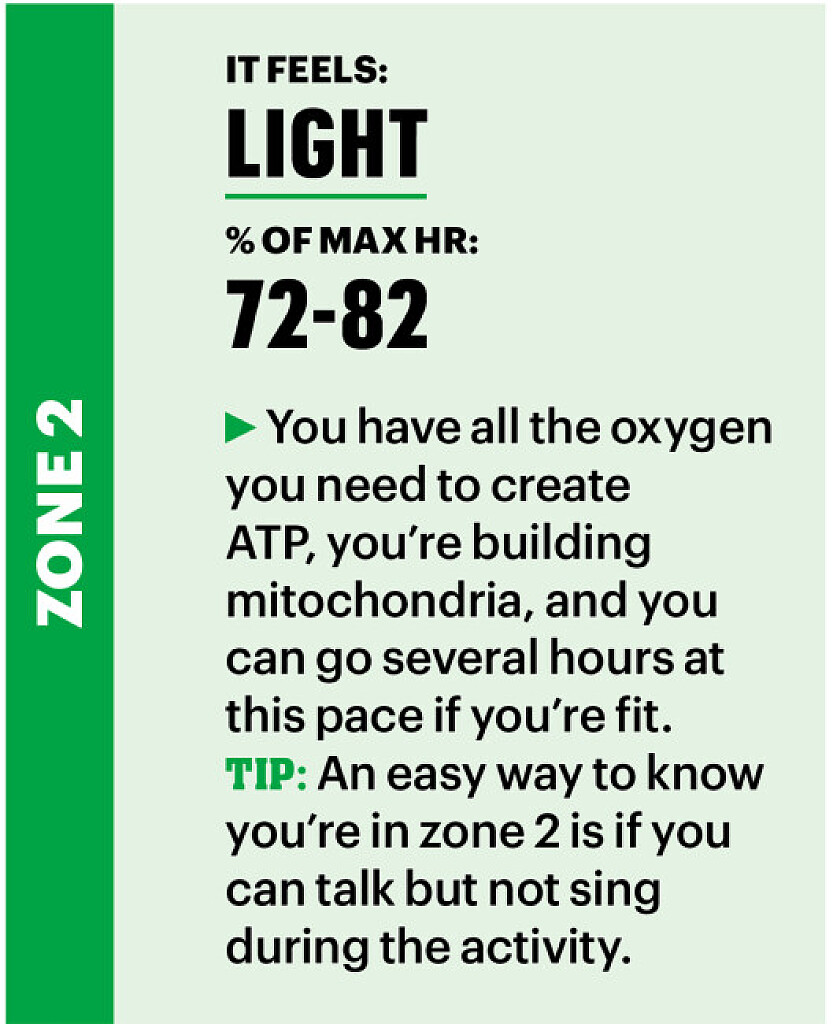Running News Daily
Running News Daily is edited by Bob Anderson. Send your news items to bob@mybestruns.com Advertising opportunities available. Train the Kenyan Way at KATA Kenya and Portugal owned and operated by Bob Anderson. Be sure to catch our movie A Long Run the movie KATA Running Camps and KATA Potato Farms - 31 now open in Kenya! https://kata.ke/
Index to Daily Posts · Sign Up For Updates · Run The World Feed
Why You Need Zone 2 Training in Your Workout Plan
How easy workouts can bring big rewards.
A minute ago, high-intensity interval training (HIIT) was king. Now that gut-it-out-and-get-the-glory work might need to share the crown with slow and steady efforts, thanks to what they do for your body, your longevity, and maybe even your mind.

These are the famous zone 2 workouts—keeping your heart rate between about 70 and 80 percent of its maximum—that runners, smart gymgoers, and everyone with a podcast is talking about these days. Think of zone 2 as the range between easy and moderate cardio, where you can carry on a conversation but someone on the other end of a phone would know you’re not sitting down. (Find out more on how to know you’re in the zone by checking out the chart below.)
What happens in zone 2 powers up your endurance, your lifting routine, and your general performance as a human being, proponents say. Here’s what to know about the zone.
How an Easy Effort Brings You Gains
Endurance athletes, such as marathoners, cyclists, and Ironmen, have long understood that zone 2 training is a key to performing well on race day. Look at Eliud Kipchoge, the world’s fastest marathoner, who spends four days a week running in zones so low that any decent runner could keep up with him. Lower-zone training yields high results in endurance sports, says Mike T. Nelson, Ph.D., C.S.C.S., owner of Extreme Human Performance, possibly “because the athletes aren’t out there just trying to fry themselves crazy every single day.” A long Z2 effort today leaves room for more time on your feet or in the saddle the next day. But another huge perk of Z2 training, no matter your sport, is the adaptations your body is making deep within your cells.
It all goes back to your mitochondria, the parts of your cells that generate ATP—that’s the fuel that drives muscle contractions. With age, your mitochondria get kind of like old dog fur: sparse, damaged, and inefficient. “Zone 2 cardio basically helps build your mitochondria,” says Kenneth Jay, Ph.D., a sports scientist who’s done research with the National Research Centre for the Working Environment in Copenhagen. These workouts help you produce more of those cellular powerhouses and shed old, damaged ones. When you get out of that zone, you start using a different energy system that doesn’t stimulate mitochondria to the same extent.
These cellular improvements can help you make gains in lifting, too, by aiding your recovery between sets. People without healthy and plentiful mitochondria “just don’t have the capacity to regenerate ATP fast enough to repeat something. And what they are repeating is half the output of what they were doing at the beginning, so they’re not getting the stimulus that they could,” Nelson says.
Building mitochondria might not get you ripped, but it deserves a lot of cred given that “mitochondrial dysfunction” has been linked to cardiovascular disease, cancer, diabetes, and obesity. Shoring them up with Z2 essentially gives you a more efficient engine to get through life on. “It’s like a hybrid car,” explains Stephen Seiler, Ph.D., a professor of sports science at the University of Agder in Kristiansand, Norway, who’s studied the effects of high- and low-intensity zone training in athletes. Redlining your workouts saps battery power. “You can run off the battery for a little while, but to pay it back, you’ve got to have your main engine.” Consistent Z2 work not only helps you recover better between sets or workouts, but it also helps you get better at everyday challenges: a family hike, an extra-long-haul rush to your flight gate, or a grueling workweek.
Does Zone 2 Work Have to Be Cardio?
In general, yes. That’s because a big benefit of zone 2 cardio is that it helps keep your heart strong and, basically, stretchy. When you lift heavy, your heart’s left ventricle—the one that pumps oxygenated blood to the rest of your body—gets tough, too. Heavy loads make your heart contract in a way that causes it to lay down more muscle fibers. But it lays them down inside the chamber, so there’s less room for blood. (Don’t get smug, endurance folks; a huge amount of cardio makes yours too thin and can leave you vulnerable to issues like atrial fibrillation.) Zone 2 cardio moves blood through the heart in a way that keeps walls at a healthy thickness and stretchiness, so it functions better, says Jay.
There’s debate on exactly how much time you need in Z2 to get the benefits. If you’re mostly sedentary now, any amount of low-intensity movement will help. If you’re somewhat or very fit, experts typically promote a minimum of 30 to 40 minutes of zone 2 cardio twice a week. (For endurance athletes, 80 percent of total training volume in Z2 is a good guideline). The trick is not turning that cardio workout into a sprint endorphin rush. Once you start pushing the intensity, cellular by-products (lactate) begin to accumulate and a different energy-producing process starts to take over. And that’s not what you want to train in these workouts.
Zone 2 is chat-paced work, so bring friends. Fit people might need more than a casual walk; hiking and rucking uphill can get you there. Keep it interesting in the gym by giving ten minutes each to the rower, bike, and treadmill. The key is control. “There is a warrior aspect to this as well,” Seiler says. When you have the discipline to stay in the zone, “there can be a Zen there in going out and finding your rhythm and not be influenced by the person who runs past you that day,” he says.
When it comes to creating a more efficient engine, easy really does do it. It’s not like you can’t have go-hard-or-go-home workouts; you need those, too. But being smart about adding a little low can feed your high.
by Men’s Health
Login to leave a comment




